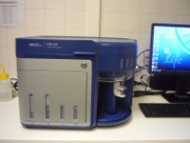Flow Cytometry
Flow cytometry is a technology that simultaneously measures and then analyses multiple physical characteristics of single particles as they flow in a fluid stream through a beam of light.
Application examples:
- Immunophenotyping
- Cell cycle analysis
- Cell proliferation
- Apoptosis
- GFP and RFP detection among other reporter molecules
- Microbiological applications
- Analysis of different type of samples
We operate with the Attune™Acoustic Focusing Cytometer, a 2-laser (red and blue), 6-colours system that uses ultrasonic waves in combination with hydrodynamic forces, to position cells into a single, focused line along the central axis of a capillary allowing the collection of more photons for high-precision analysis at superior volumetric sample throughput. This highly sensitive system is designed to acquire data at up to 35000 events/second, detect particles with diameters from 0.5 µm to 50 µm and rare events at sample rates up to 1000 μL/min. The Attune™ Software is designed to provide powerful data acquisition and analysis and can perform pre- and post-compensation (automated or manual).

Latest publications with our Attune™ Acoustic Focusing Cytometer:
Figueiredo-Pereira, C. et al. Carbon Monoxide Stimulates Both Mitophagy And Mitochondrial Biogenesis to Mediate Protection Against Oxidative Stress in Astrocytes. Mol. Neurobiol. 60, 851-863 (2023).
https://doi.org/10.1007/s12035-022-03108-7
Lenis-Rojas, O. A. et al. Manganese(I) tricarbonyl complexes as potential anticancer agents. J. Biol. Inorg. Chem. 27, 49-64 (2022).
https://doi.org/10.1007/s00775-021-01910-7
Lenis-Rojas, O. A. et al. In Vitro and In Vivo Biological Activity of Ruthenium 1,10-Phenanthroline-5,6-dione Arene Complexes. Int. J. Mol. Sci. 23, (2022).
https://doi.org/10.3390/ijms232113594
Nuez-Martínez, M. et al. Boron clusters (ferrabisdicarbollides) shaping the future as radiosensitizers for multimodal (chemo/radio/PBFR) therapy of glioblastoma. J. Mater. Chem. B 10, 9794-9815 (2022).
https://doi.org/10.1039/D2TB01818G
Flow Cytometry
Flow cytometry is a technology that simultaneously measures and then analyses multiple physical characteristics of single particles as they flow in a fluid stream through a beam of light.
Application examples:
- Immunophenotyping
- Cell cycle analysis
- Cell proliferation
- Apoptosis
- GFP and RFP detection among other reporter molecules
- Microbiological applications
- Analysis of different type of samples
We operate with the Attune™Acoustic Focusing Cytometer, a 2-laser (red and blue), 6-colours system that uses ultrasonic waves in combination with hydrodynamic forces, to position cells into a single, focused line along the central axis of a capillary allowing the collection of more photons for high-precision analysis at superior volumetric sample throughput. This highly sensitive system is designed to acquire data at up to 35000 events/second, detect particles with diameters from 0.5 µm to 50 µm and rare events at sample rates up to 1000 μL/min. The Attune™ Software is designed to provide powerful data acquisition and analysis and can perform pre- and post-compensation (automated or manual).

Latest publications with our Attune™ Acoustic Focusing Cytometer:
Figueiredo-Pereira, C. et al. Carbon Monoxide Stimulates Both Mitophagy And Mitochondrial Biogenesis to Mediate Protection Against Oxidative Stress in Astrocytes. Mol. Neurobiol. 60, 851-863 (2023).
https://doi.org/10.1007/s12035-022-03108-7
Lenis-Rojas, O. A. et al. Manganese(I) tricarbonyl complexes as potential anticancer agents. J. Biol. Inorg. Chem. 27, 49-64 (2022).
https://doi.org/10.1007/s00775-021-01910-7
Lenis-Rojas, O. A. et al. In Vitro and In Vivo Biological Activity of Ruthenium 1,10-Phenanthroline-5,6-dione Arene Complexes. Int. J. Mol. Sci. 23, (2022).
https://doi.org/10.3390/ijms232113594
Nuez-Martínez, M. et al. Boron clusters (ferrabisdicarbollides) shaping the future as radiosensitizers for multimodal (chemo/radio/PBFR) therapy of glioblastoma. J. Mater. Chem. B 10, 9794-9815 (2022).
https://doi.org/10.1039/D2TB01818G
